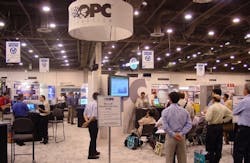Welcome to the October 2005 edition of “OPConnect,” the official newsletter of the OPC Foundation. 2005 has definitely been a banner year, with respect to the activities of the OPC Foundation, and 2006 promises to bring even more developments, as vendors deliver products built on the OPC Unified Architecture. The OPC Unified Architecture has become synonymous with end-user driven, industrial-strength open architecture.
OPC UA at ISA
The OPC Unified Architecture (UA) has hit the ground running, with the demonstration of the technology at the OPC Foundation booth at the ISA Expo, held in Chicago the week of October 24. The clear message from the end-users is positive acknowledgement of the OPC UA vision to provide secure, reliable interoperability and resolve configuration headaches.
The demonstration focuses on maintenance-free, reliable interoperability, by taking existing OPC Distributed Component Object Model (DCOM)-based products and transforming them into products that are part of the information solution for enterprise-wide communication.
End-users want data integrity
The OPC Foundation is committed to identifying the requirements and feature sets that the end-users really want. As part of this process, the OPC Foundation, in collaboration with the Instrumentation, Systems and Automation (ISA) Society, the Open Modular Architecture Controls (OMAC) group and the Microsoft Manufacturing Users Group (MS-MUG), developed a series of questions that was sent as a survey to the end-user community.
The results of the survey drive home the importance of solving end-users' problems with DCOM and system reliability, and the need for real vendor commitment to a certification program. Clearly, the end-users have spoken—they will no longer tolerate reliability and data integrity problems.
The value proposition for the OPC Foundation is to provide the technology and processes that are aligned with these end-user requirements for secure, reliable interoperability. The Foundation is not in business to develop specifications that are not worth the paper they're printed on. As we move forward in 2006, you will see a renewed effort by the end-users to mandate that the OPC vendors develop products that are OPC certified and guaranteed to be interoperable.
Marketing programs in 2006
2006 marks the official 10-year anniversary of the OPC Foundation. The Foundation will roll out a major marketing program targeted at turning the world upside-down, with respect to vendors' and end-users' commitment to secure, reliable interoperability. The overriding theme of the OPC Foundation 2006 marketing programs will be meeting the end-users' needs with vendor products that deliver on reliability, interoperability and data integrity.
As we continue to blitz the industry with OPC evangelism, the key aspects of the 2006 marketing program will include: Multi-city road shows focused on end-user training and applications; Partner summits between the OPC Foundation and Microsoft; an enhanced "OPConnect" newsletter program; and the "OPC Is Everywhere" advertisement program.
OPC collaboration
The OPC Foundation Unified Architecture is truly a collaborative effort that spans standards organizations, international teams, multiple vendors and multiple industries. It delivers a solid, service-oriented platform focused at secure, reliable interoperability to provide data and information exchange between the factory floor and the enterprise.
This collaborative arrangement even goes beyond automation, to include the areas of Web Services and security. It provides faster time-to-market and lower costs for both the OPC Foundation technology and products from the OPC vendors. Collaboration with organizations outside of automation provides a whole new opportunity to integrate in ways we never dreamed. Imagine integrating your point-of-sale systems on the retail side using the same technology as your automation systems. Stay tuned to future issues of "OPConnect" for more on this important topic.
Please visit the OPC Foundation Web site, www.opcfoundation.org, for more information about the OPC Unified Architecture and the overall vision of the OPC Foundation.

